Term 3 Unit 3 | History | 6th Social Science - The Age of Empires: Guptas and Vardhanas | 6th Social Science : History : Term 3 Unit 3 : The Age of Empires: Guptas and Vardhanas
Chapter: 6th Social Science : History : Term 3 Unit 3 : The Age of Empires: Guptas and Vardhanas
The Age of Empires: Guptas and Vardhanas
Unit 3
The Age
of Empires: Guptas and Vardhanas
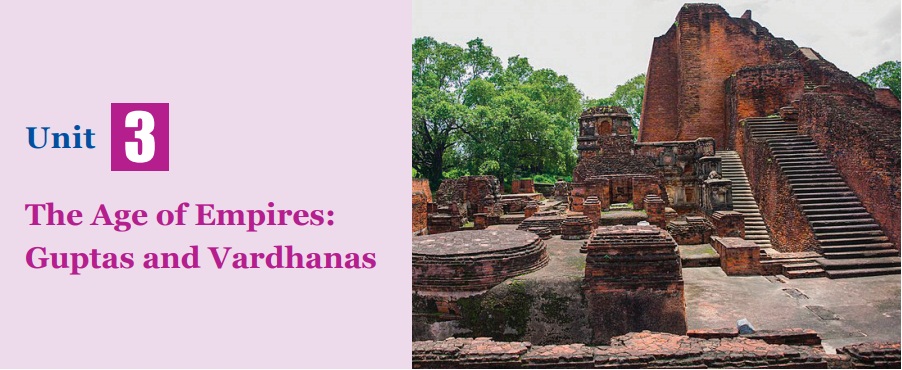
Learning Objectives
• To know the establishment of Gupta
dynasty and the empire-building efforts of Gupta rulers
• To understand the polity, economy
and society under Guptas
• To
get familiar with
the contributions of
the Guptas to
art, architecture, literature,
education, science and technology
• To explore the signification of
the reign of Harsha Vardhana
Introduction
By the end of the
3rd century, the powerful empires established by the Kushanas in the north and
Satavahanas in the south had lost their greatness and strength. After the
decline of Kushanas and Satavahanas, Chandragupta carved out a kingdom and
establish his dynastic rule, which lasted for about two hundred years. After
the downfall of the Guptas and thereafter and interregnum of nearly 50 years,
Harsha of Vardhana dynasty ruled North India from 606 to 647 A.D (CE).
Sources
Archaeological
Sources
* Gold, silver and copper coins issued by Gupta
rulers.
* Allahabad Pillar Inscription of Samudragupta.
* The Mehrauli Iron Pillar Inscription. „
* Udayagiri Cave Inscription, MathuraStone
Inscription and Sanchi Stone Inscription of Chandragupta II.
* Bhitari Pillar Inscription of Skandagupta.
* The Gadhwa Stone Inscription.
* Madubhan
Copper Plate Inscription
* Sonpat Copper
Plate
* Nalanda
Inscription on clay seal
Literary
Sources
* Vishnu, Matsya, Vayu and Bhagavata Puranas and
Niti Sastras of Narada
* Visakhadatta’s Devichandraguptam and
Mudrarakshasa and Bana’s Harshacharita
* Dramas of Kalidasa
* Accounts of Chinese Buddhist monk Fahien who
visited India during the reign of Chandragupta II.
* Harsha’s Ratnavali, Nagananda, Priyadharshika
* Hiuen-Tsang's Si-Yu-Ki
Foundation
of the Gupta Dynasty
Sri Gupta is
considered to be the founder of the Gupta dynasty. He is believed to have
reigned over parts of present-day Bengal and Bihar. He was the first Gupta
ruler to be featured on coins. He was succeeded by his son Ghatotkacha. Both are
mentioned as Maharajas in inscriptions.
Chandragupta
I (c.
319–335 AD(CE))
Chandragupta I
married Kumaradevi of the famous and powerful Lichchhavi family. Having gained
the support of this family, Chandragupta could eliminate various small states
in northern India and crown himself the monarch of a larger kingdom. The gold
coins attributed to Chandragupta bear the images of Chandragupta, Kumaradevi
and the legend ‘Lichchhavayah’.
Lichchhavi was an old gana–sanga and
its territory lay between the Ganges and the Nepal Terai.
Samudragupta
(c. 335–380)
Samudragupta, son
of Chandragupta I, was the greatest ruler of the dynasty. The Prayog Prashasti,
composed by Samudragupta’s court poet Harisena was engraved on Allahabad
Pillar. This Allahabad Pillar inscription is the main source of information for
Samudragupta’s reign.
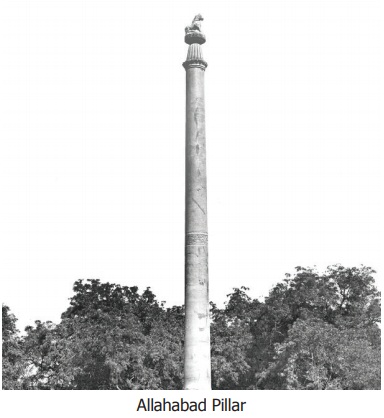
Prashasti Prashasti is a Sanskrit word,
meaning commendation or ‘in praise of’. Court poets flattered their kings
listing out their achievements. These accounts were later engraved on pillars
so that the people could read them.
Consolidation of Gupta Dynasty
Samudragupta was a
great general and when he became emperor, he carried on a vigorous campaign all
over the country and even in the south. In the southern Pallava kingdom, the
king who was defeated by Samudragupta was Vishnugopa.
Samudragupta
conquered nine kingdoms in northern India. He reduced 12 rulers of the southern
India to the status of feudatories and forced them to pay tribute. He received
homage from the rulers of East Bengal, Assam, Nepal, the eastern part of Punjab
and various tribes of Rajasthan.
Samudragupta was a devotee of
Vishnu. He revived the Vedic practice of performing horse sacrifice to
commemorate victories in wars. He issued gold coins and in one of them, he is
portrayed playing harp (veenai). Samudragupta was not only a great conqueror
but a lover of poetry and music and for this, he earned the title ‘Kaviraja’.
Srimeghavarman, the Buddhist king of
Ceylon, was a contemporary of Samudragupta.
Chandragupta
II (c.380 - 415)
Chandragupta II was
the son of Samudragupta. He was also known as Vikramaditya. He conquered
western Malwa and Gujarat by defeating the Saka rulers. He maintained friendly
relationship with the rulers of southern India. The iron pillar near Qutub
Minar is believed to have been built by Vikramaditya. Fahien, a Buddhist
scholar from China, visited India during his reign. Vikramaditya is said to
have assembled the greatest writers and artists (Navaratna [Nine Jewels]) in
his court. Kalidasa is said to be one among them.
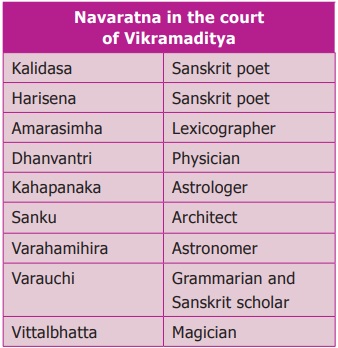
The surnames of Chandragupta II were
Vikramaditya, Narendrachandra, Simhachandra, Narendrasimha, Vikrama Devaraja,
Devagupta and Devasri.
Chandragupta II was
succeeded by his son Kumaragupta I, who built the famous Nalanda University.
Kumaragupta’s
successor Skandagupta had to face a new threat in the form of the invasion of
Huns. He defeated them and drove them away. But after twelve years, they came
again and broke the back of the Gupta Empire. The last of the great Guptas was
Baladitya, assumed to have been Narasimha Gupta I.
Fahien
During the reign of Chandragupta II,
the Buddhist monk Fahien visited India. His travel accounts provided us
information about the socio-economic, religious and moralconditions of the
people of the Gupta age. According to Fahien, the people of Magadha were happy
and prosperous, that justice was mildly administered and there was no death
penalty. Gaya was desolated. Kapilavasthu had become a jungle, but at
Pataliputra people were rich and prosperous.
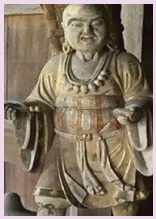
He was himself
attracted towards Buddhism. He was paying tribute to Mihirakula but was
distressed by his hostility towards Buddhism. So he stopped paying tribute.
Though Baladitya succeeded in imprisoning him, Mihirakula turned treacherous
and drove away Baladitya from Magadha. After Baladitya, the great Gupta Empire
faded away.
The last recognised
king of the Gupta Empire was Vishnugupta.
Gupta Polity
The divine theory
of kingship (the concept that king is the representative of God on earth and so
he is answerable only to God and not to anyone else) was practised by the Gupta
rulers. The Gupta kings wielded enormous power in political, administrative,
military and judicial spheres. The Gupta king was assisted by a council of mantris
(ministers). The council consisted of princes, high officials and feudatories.
A large number of officials were employed by the Gupta rulers to carry on the
day-to-day administration of the country. High-ranking officials were called dandanayakas
and mahadandanayakas.
The Gupta Empire
was divided into provinces known as deshas or bhuktis. They were
administered by the governors, designated as uparikas. The province was
divided into districts such as vishyas and they were controlled
by the officers known as vishyapatis. At the village level, there
were functionaries such as gramika and gramadhyaksha.
The extensive
empire shows the important role of military organisation. Seals and
inscriptions mentioned military designations as baladhikrita and mahabaladhikrita
(commander of infantry and cavalry respectively). The system of
espionage included spies known as dutakas.
Society and
Economy
Land and Peasants
Nitisara, authored by Kamandaka, emphasises
the importance of the royal treasury and mentions various sources of revenue.
The military campaigns of kings like Samudragupta were financed through revenue
surpluses. Land tax was the main revenue to the government. The condition of
peasants was pathetic. They were required to pay various taxes. They were
reduced to the position of serfs.
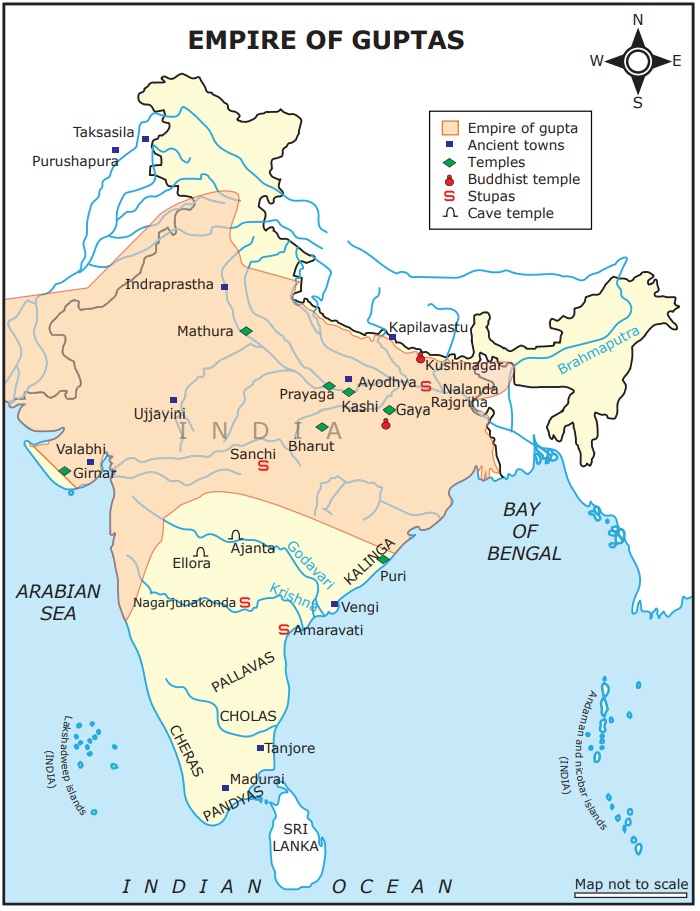
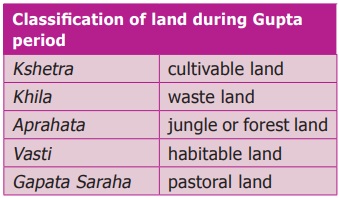
Trade and
Commerce
The
contribution of the
traders for the
development of Gupta’s
economy was very
impressive. There were
two types of
traders, namely Sresti and Sarthavaha.
Nalanda University
* Nalanda University flourished
under the patronage of the Gupta Empire in the 5th and 6th centuries and later
under emperor Harsha of Kanauj.
* At Nalanda, Buddhism was the main subject
of study. Other subjects like Yoga, Vedic literature and Medicine were also
taught.
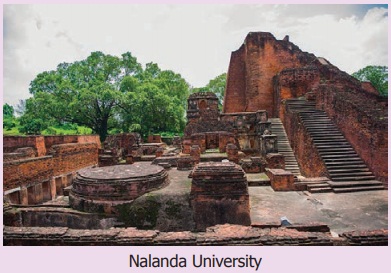
* Hiuen Tsang spent many years studying
Buddhism in the University.Eight Mahapatashalas and three large Nalanda
Universit libraries were situated on the campus.
* Nalanda was ravaged and destroyed
by Mamluks (Turkish Muslims) under Bhaktiyar Khalji.
* Today, it is a UNESCO World Heritage Site.
Who were the Huns? Huns were the
nomadic tribes, who, under their great Attila, were terrorising Rome and
Constantinople. Associated with these tribes were the White Huns who came to
India through Central Asia. They undertook regular invasions and were giving
trouble to all Indian frontier states. After defeating Skandagupta, they spread
across Central India. Their chief, Toromana, crowned himself as king. After
him, his son Mihirakula ruled the captured territories. Finally, Yasodharman,
ruler of Malwa in Central India, defeated them and ended their rule.

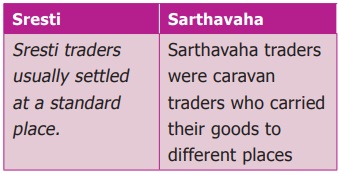
Trade items ranged
from daily products to valuable and luxury goods. The important trade goods
were pepper, gold, copper, iron, horses and elephants. Lending money at a high
rate of interest was in practice during Gupta period.
The Guptas
developed roadways connecting different parts of the country. Pataliputra,
Ujjain, Benaras, Mathura were the famous trade centres. Ports in western
(Kalyan, Mangalore, Malabar) and eastern (Tamralipti in Bengal) coasts of India
facilitated trade.
Samudragupta introduced the Gupta
monetary system. Kushana coins provided inspiration to Samudragupta. The Gupta
gold coins were known as Dinara. Guptas issued many gold coins but
comparatively fewer silver and copper coins. However, the post-Gupta period saw
a fall in the circulation of gold coins, indicating the decline in the
prosperity of the empire.
Metallurgy
* Mining and
metallurgy were the most flourishing industries during the Guptaperiod.
* The most important evidence of development in
metallurgy was the Mehrauli Iron Pillar installed by King Chandragupta in
Delhi. This monolithic iron pillar has lasted through the centuries without
rusting.
The metals used by them were: iron,
gold, copper, tin, lead, brass, bronze, bell- metal, mica, manganese and red
chalk.
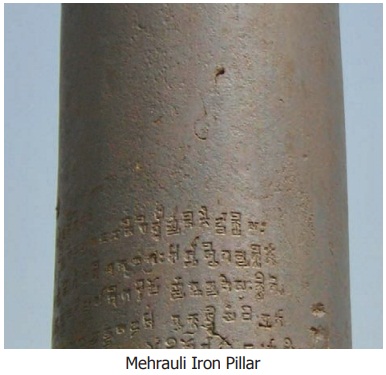
Society
The society that adhered
to four varna system was patriarchal. According to laws of Manu, which
was in force, women should be under the protection of their father, husband or
eldest son. Polygamy was widely prevalent. The kings and feudatory lords often
had more than one wife. Inscriptions refer to Kubernaga and Dhrubaswamini as
the queens of Chandragupta II. Sati was practised during the Gupta rule.
Slavery
Slavery was not
institutionalised in India, as in the West. But there are references to the
existence of various categories of slaves during the Gupta age.
Religion
There was revival
of Vedic religion and Vedic rites. Samudragupta and Kumaragupta I performed Asvamedha
Yagna (a horse sacrifice ritual). We notice the beginning of image worship and
the emergence of two sects, namely Vaishnavism and Saivism, during the Gupta
period. Buddhism also continued to flourish though it split into two sects,
namely Hinayana and Mahayana.
Art and
Architecture
The Guptas were the first to construct temples,
which evolved from the earlier tradition of rock-cut shrines. Adorned with
towers and elaborate carvings, these temples were dedicated to all Hindu
deities.
The most notable
rock-cut caves are found at Ajanta and Ellora (Maharashtra) , Bagh (Madhya
Pradesh) and Udaygiri (Odisha) . The structural temples built during this
period resemble the characteristic features of the Dravidian style.
Two remarkable
examples of Gupta metal sculpture are (i) a copper image of Buddha about 18
feet high at Nalanda and (ii) Sultanganj Buddha seven-and-a-half feet in
height. The most important examples of the Gupta paintings are found on the
Fresco of the Ajanta caves and the Bagh cave in Gwalior.
Literature
Though the language
spoken by the people was Prakrit, the Guptas made Sanskrit the official language
and all their epigraphic records are in Sanskrit. The Gupta period also saw the
development of Sanskrit grammar based on the grammar of Panini and Patanjali
who wrote Ashtadhyayi and Mahabhashya respectively.
A Buddhist scholar
from Bengal, Chandrogomia, composed a book on grammar titled Chandravyakaranam.
Kalidasa’s famous dramas were Sakunthala, Malavikagnimitra and
Vikramaoorvashiyam. Other significant works of Kalidasa were Meghaduta,
Raghuvamsa, Kumarasambava and Ritusamhara.
Mathematics,
Astronomy and Medicine
* Invention of zero
and the consequent evolution of the decimal system were the legacy of Guptas to
the modern world. Aryabhatta, Varahamihira
and Brahmagupta were foremost astronomers and mathematicians of the time.
* Aryabhatta, in
his book Surya Siddhanta, explained the true causes of solar and
lunar eclipses. He was the first Indian astronomer to declare that the earth
revolves around its own axis.
* Dhanvantri was a famous scholar in the field of medicine. He was a specialist in
Ayurveda. Charaka was a medical scientist. Susruta was the first Indian to
explain the process of surgery.
Vardhana
Dynasty
The founder of the
Vardhana or Pushyabhuti dynasty ruled from Thaneswar. Pushyabhuti served as a
military general under the Guptas and rose to power after the fall of the
Guptas. With the accession of Prabakaravardhana, the Pushyabhuti family became
strong and powerful.
Rajavardhana, the eldest son of Prabhakaravardhana,
ascended the throne after his father’sdeath. Rajavardhana's sister Rajayashri's
husband, Raja of Kanauj, was killed by the Gauda ruler Sasanka of Bengal. Sasanka
also imprisoned Rajayashri. Rajavardhana, I the process of retrieving his
sister was treacherously killed by Sasanka. This resulted in his younger
brother Harshavardhana becoming king of Thaneswar.
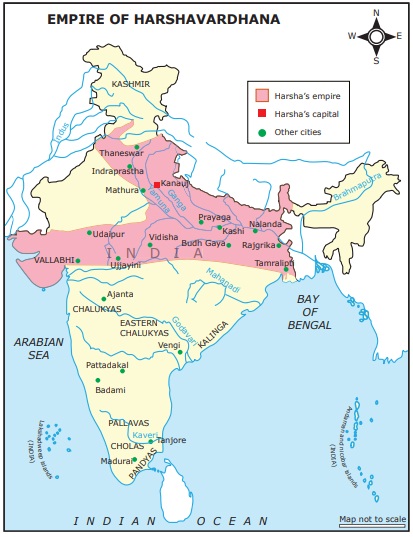
The notables of the Kanauj kingdom also invited
Harsha to take its crown. After becoming the ruler of the both Thaneswar and
Kanauj, Harsha shifted his capital from Thaneswar to Kanauj.
Conquest
of Harshavardhana
* The most popular king of the vardhana dynasty
was Harshavardhana. Harsha ruled for 41 years. His feudatories included those
of Jalandhar, Kashmir, Nepal and Valabhi. Sasanka of Bengal remained hostile to
him.
* It was Harsha who unified most of northern
India. But the extension of his authority in the south was checked by Chalukya
king Pulikesin II.
The kingdom of
Harsha disintegrated rapidly
into small states
after his death
in 648 AD
(CE). He maintained a cordial
relationship with the rulers of
Iran and China.
Harsha met
the Chinese traveller,
Hiuen Tsang, at
Kajangala near Rajmahal (Jharkhand) for the first time.
Administration
The emperor was assisted by a council of
ministers. The prime minister occupied the most important position in the
council of ministers. Bhaga, Hiranya andBali were the three kinds of tax
collected during Harsha’s reign. Criminal law was more severe than that of the
Gupta age. Life imprisonment was the punishment for violation of the laws and
for plotting against the king.
Perfect law and order prevailed throughout the
empire. Harsha paid great attention to discipline and strength of the army.
Harsha built charitable institutions for the stay of the travellers, and to care
for the sick and the poor.

Religious
Policy
Harsha was the
worshipper of Shiva in the beginning, but he embraced Buddhism under the
influence of his sister Rajyashri and the Buddhist monk and traveller Hiuen
Tsang. He belonged to Mahayana school of thought. Harsha treated Vedic scholars
and Buddhist monks alike and distributed charities equally to them. He was the
last Buddhist sovereign in India. As a pious Buddhist, Harsha stopped the
killing of animals for food.
Hiuen Tsang, the ‘prince of
pilgrims’, visited India during Harsha’s reign. His Si-Yu-Ki provides detailed
information about the social, economic, religious and cultural conditions of
India during Harsha’s time. Hiuen Tsang tells us how Harsha, though a Buddhist,
went to participate in the great kumbhamela held at Prayag.
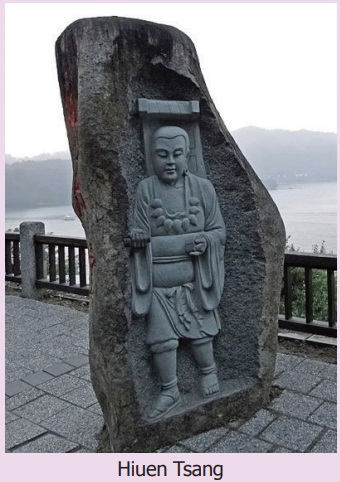
He was noted for
his policy of religious toleration and used to worship the images of Buddha,
Shiva and Sun simultaneously. He summoned two Buddhist assemblies, one at
Kanauj and another at Prayag.
The assembly at Kanauj was attended
by 20 kings. A large number of Buddhist, Jain and Vedic scholars attended the
assembly. A golden statue of Buddha was consecrated in a monastery and a small
statue of Buddha (three feet) was carried in a procession.
In the assembly at Prayag, Harsha
distributed his wealth among the Buddhists, Vedic scholars and poor people.
Harsha offered fabulous gifts to the Buddhist monks on all the four days of the
assembly.
Art and
Literature
Harsha, himself a
poet and dramatist, gathered around him a best of poets and artists. Harsha’s
popular works are Ratnavali, Nagananda and Priyadharshika. His
royal court was adorned by Banabhatta, Mayura, Hardatta and Jayasena.
Temples and monasteries functioned as centres of learning. Kanauj became a famous city. Harsha constructed a large number of viharas, monasteries and stupas on the bank of the Ganges. The Nalanda University, a university and monastery combined, was said to have had 10,000 students and monks in residence, when Hiuen Tsang visited the university.
Elsewhere
Chandragupta I was the contemporary
of Constantine the Great, the Roman Emperor, who founded Constantinople.
Harsha’s time coincided with a early
days of Tang Dynasty of China. Their capital(Xi’an) was a great centre of art
and learning.
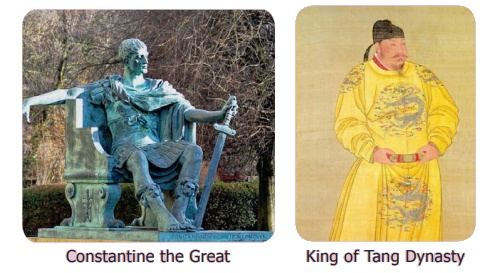
Summary
* Sri Gupta was the founder of Gupta dynasty
* Chandragupta I, Samudragupta and Chandragupta II
were the great kings of Gupta dynasty
* Vishnugupta was the last recognised king of
Gupta Empire
* Divine Right Theory of kingship was practised by
the Gupta rulers
* Mining and metallurgy were the most flourishing
industries during the Gupta Period
* The society that adhered to four varna system
was patriarchal
* There was a revival of Vedic religion and Vedic
rites
* The Guptas were the first to construct temples
which evolved from the earlier tradition of rock-cut shrines
*Aryabhatta, Varahamihira and Brahmagupta were
foremost astronomers and mathematicians of the time
* Harsha
was a prominent ruler of Vardhana dynasty and was elevated to the position of
an emperor
* Harsha was a great artist and dramatist and
contributed to the development of literature and art
* Hiuen Tsang visited Nalanda and wrote his useful
travel accounts, which help us understand the condition of India during
Harsha’s reign
* Harsha, though a strong follower of Buddhism,
also promoted Vedic religion
GLOSSAY
1. Engraved
carved/inscribed பொறிக்கப்பட்ட (செதுக்கிய)
2. Flattered
lavish insincere praise and compliments upon (someone) especially to further
one’s own interest முகஸ்துதி
3. Collapse
fall சரிவு
4. Pathetic
pitiful பரிதாபகரமான
5. adhered
to abide by, bound by பின்பற்றப்பட்ட
6. pastoral
land land or farm used for grazing cattle மேய்ச்சல் நிலம்
7. Portrayed
depicted in a work of art or literature சித்தரிக்கப்பட்டுள்ளது
8. Desolated
made unfit for habitation பாழடைந்த
ICT CORNER
HISTORY -
THE AGE OF EMPIRES:
GUPTAS
AND VARDHANAS
This activity is to explore Maps. You knowabout
countries, capitals, flags and cities in ll thecontinents using an Educational
Interactive game Settera Map Quiz.
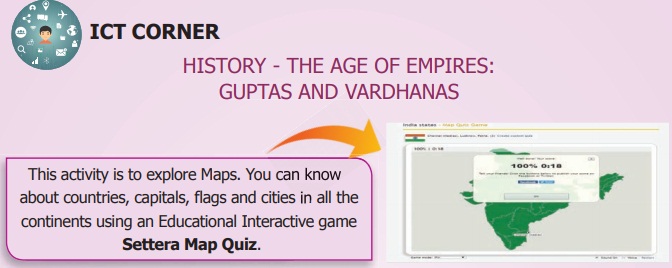
Steps:
Step 1: Open the Browser and type the given URL
(or) Scan the QR Code.
Step 2: Free map Quiz page will appear on the
screen.
Step 3: Scroll down and You can select any
continent or Country (ex. India Cities)
Step 4: Explore various places on the map, play
and create customized quiz activities.

*Pictures are indicatives
only.
Browse in the link
Web: https://online.seterra.com/en/
(or) scan the QR Code
Mobile : https://play.google.com/store/apps/details?id=com.seterra.free
Related Topics